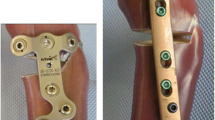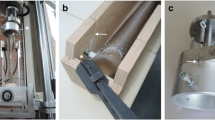Abstract
Open-wedge high tibial osteotomy (HTO) is becoming increasingly popular for the treatment of varus gonarthrosis in the active patient. The various implants used in HTO differ with regard to its design, the fixation stability and osteotomy technique. It is assumed that the combination of a plate fixator with a biplanar, v-shaped osteotomy supports bone healing. So far, there are no biomechanical studies that quantify the stabilizing effect of a biplanar versus uniplanar osteotomy. We hypothesized that a significant increase in primary stability of bone-implant constructs is achieved when using a biplanar as opposed to a uniplanar osteotomy. Twenty-four fresh-frozen human tibiae were mounted in a metal cylinder, and open-wedge osteotomy (12 mm wedge size) was performed in a standardized fashion. Proximal and distal tibial segments were marked with tantalum markers of 0.8 mm diameter. Two different plates with locking screws were used for fixation: a short spacer plate (group 1, n = 12) and a plate fixator (group 2, n = 12). In six specimens of each group, a biplanar V-shaped osteotomy with a 110° angulated anterior cut behind the tuberosity parallel to the ventral tibial shaft axis was performed. In the remaining six specimens of each group, a simple uniplanar osteotomy was performed in an oblique fashion. Axial compression of the tibiae was performed using a material testing machine under standardized alignment of the loading axis. Load-controlled cyclical staircase loading tests were performed. The specimens were radiographed simultaneously in two planes together with a biplanar calibration cage in front of a film plane with and without load after each subcycle. Radiostereometry allowed for serial quantification of plastic and elastic micromotion at the osteotomy site reflecting the stability provided by the combination of implant and osteotomy technique. No significant additional stabilizing effect of a biplanar osteotomy in craniocaudal and mediolateral plane was found. However, additional stability was achieved in anteroposterior (AP) and all rotational planes in those specimens fixated with a short spacer plate. In this biomechanical set-up with axial load, the additional stabilizing effect of a biplanar osteotomy did not come into effect in the presence of a long and rigid plate fixator. However, biplanar osteotomy increased the fixation stability significantly in AP and rotational planes when a short spacer plate was used. Clinically, the biplanar osteotomy promotes bone healing regardless of the implant used. Biomechanically, biplanar osteotomy is advantageous for shorter plate designs to increase primary stability of the bone-implant construct.






Similar content being viewed by others
References
Agneskirchner JD, Freiling D, Hurschler C, Lobenhoffer P (2006) Primary stability of four different implants for opening wedge high tibial osteotomy. Knee Surg Sports Traumatol Arthrosc 14:291–300
Dahlberg G (1940) Statistical methods for medical and biological students. Interscience Publications, New York
Dorsey WO, Miller BS, Tadje JP, Bryant CR (2006) The stability of three commercially available implants used in medial opening wedge high tibial osteotomy. J Knee Surg 19:95–98
Flamme CH, Kohn D, Kirsch L, Hurschler C (1999) Primary stability of different implants used in conjunction with high tibial osteotomy. Arch Orthop Trauma Surg 119:450–455
Flierl S, Sabo D, Hornig K, Perlick L (1996) Open wedge high tibial osteotomy using fractioned drill osteotomy: a surgical modification that lowers the complication rate. Knee Surg Sports Traumatol Arthrosc 4:149–153
Fowler P, Tan L, Brown G (2000) Medial opening wedge high tibial osteotomy: how I do it. Oper Tech Sports Med 8:32–38
Fujisawa Y, Masuhara K, Shiomi S (1979) The effect of high tibial osteotomy on osteoarthritis of the knee. An arthroscopic study of 54 knee joints. Orthop Clin North Am 10:585–608
Gaasbeek RD, Welsing RT, Verdonschot N, Rijnberg WJ, van Loon CJ, van Kampen A (2005) Accuracy and initial stability of open- and closed-wedge high tibial osteotomy: a cadaveric RSA study. Knee Surg Sports Traumatol Arthrosc 13:689–694
Kellgren JH, Lawrence JS (1957) Radiological assessment of osteo-arthrosis. Ann Rheum Dis 16:494–502
Lobenhoffer P, De Simoni C, Staubli A (2002) Open-wedge high-tibial osteotomy with rigid plate fixation. Tech Knee Surg 1:93–105
Lobenhoffer P, Agneskirchner JD (2003) Improvements in surgical technique of valgus high tibial osteotomy. Knee Surg Sports Traumatol Arthrosc 11:132–138
Miller BS, Dorsey WO, Bryant CR, Austin JC (2005) The effect of lateral cortex disruption and repair on the stability of the medial opening wedge high tibial osteotomy. Am J Sports Med 33:1552–1557
Pape D, Adam F, Seil R, Georg T, Kohn D (2005) Fixation stability following high tibial osteotomy: a radiostereometric analysis. J Knee Surg 18:108–115
Pape D, Duchow J, Rupp S, Seil R, Kohn D (2006) Partial release of the superficial medial collateral ligament for open-wedge high tibial osteotomy. A human cadaver study evaluating medial joint opening by stress radiography. Knee Surg Sports Traumatol Arthrosc 14:141–148
Selvik G (1978) A stereophotogrammetric system for the study of human movements. Scand J Rehabil Med Suppl 6:16–20
Selvik G, Alberius P, Aronson AS (1983) A roentgen stereophotogrammetric system. Construction, calibration and technical accuracy. Acta Radiol 24:343–352
Spahn G, Muckley T, Kahl E, Hofmann GO (2006) Biomechanical investigation of different internal fixations in medial opening-wedge high tibial osteotomy. Clin Biomech 21:272–278
Stoffel K, Stachowiak G, Kuster M (2004) Open wedge high tibial osteotomy: biomechanical investigation of the modified arthrex osteotomy plate and the tomofix plate. Clin Biomech 19:944–950
Stuart MJ, Beachy AM, Grabowski JJ, An KN, Kaufman KR (1999) Biomechanical evaluation of a proximal tibial opening-wedge osteotomy plate. Am J Knee Surg 12:148–153
Valstar ER, Gill R, Ryd L, Flivik G, Borlin N, Karrholm J (2005) Guidelines for standardization of radiostereometry (RSA) of implants. Acta Orthop 76:563–572
Taylor WR, Heller MO, Bergmann G, Duda GN (2004) Tibio-femoral loading during human gait and stair climbing. J Orthop Res 22:625–629
Zhim F, Laflamme GY, Viens H, Laflamme GH, Yahia L (2006) Biomechanical stability of a retrotubercle opening-wedge high tibial osteotomy. J Knee Surg 19:28–321
Acknowledgment
This study was supported by the AO Research Grant 04-P18.
Author information
Authors and Affiliations
Corresponding author
Rights and permissions
About this article
Cite this article
Pape, D., Lorbach, O., Schmitz, C. et al. Effect of a biplanar osteotomy on primary stability following high tibial osteotomy: a biomechanical cadaver study. Knee Surg Sports Traumatol Arthrosc 18, 204–211 (2010). https://doi.org/10.1007/s00167-009-0929-3
Received:
Accepted:
Published:
Issue Date:
DOI: https://doi.org/10.1007/s00167-009-0929-3




